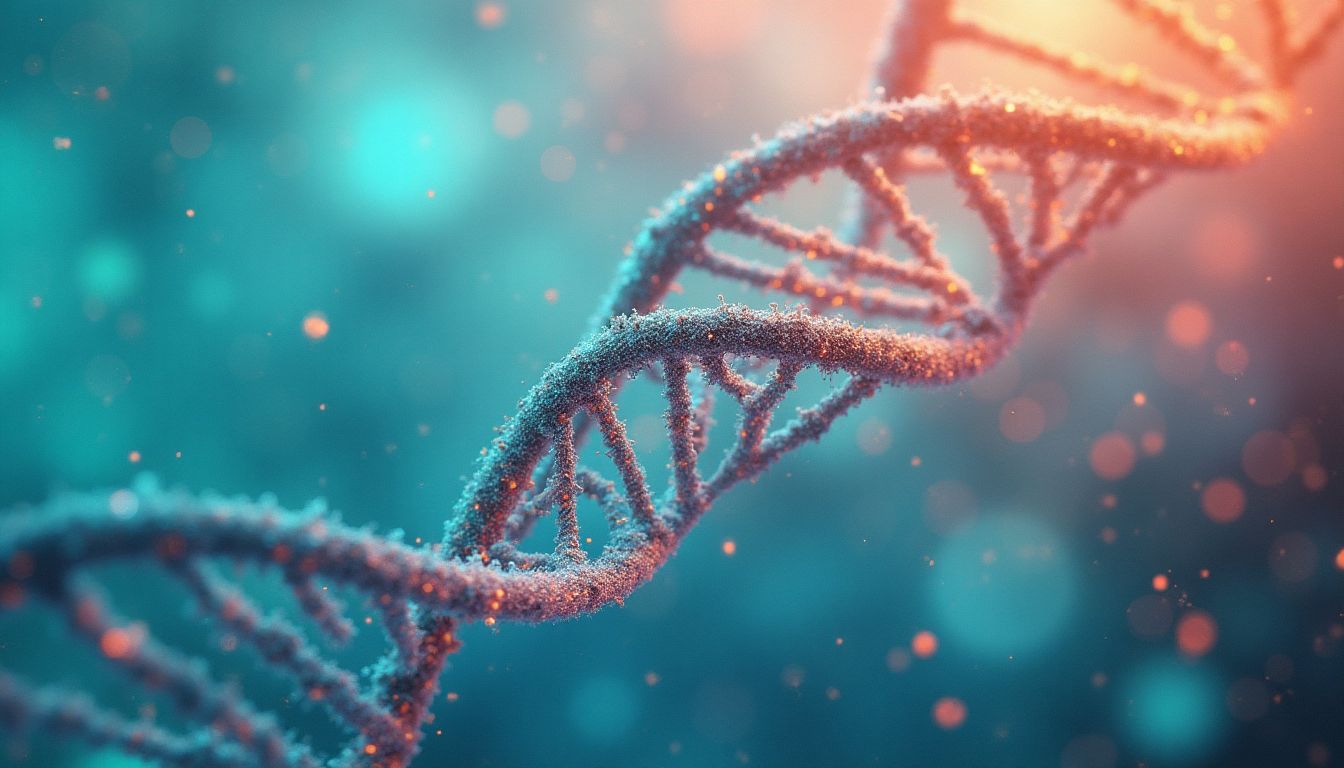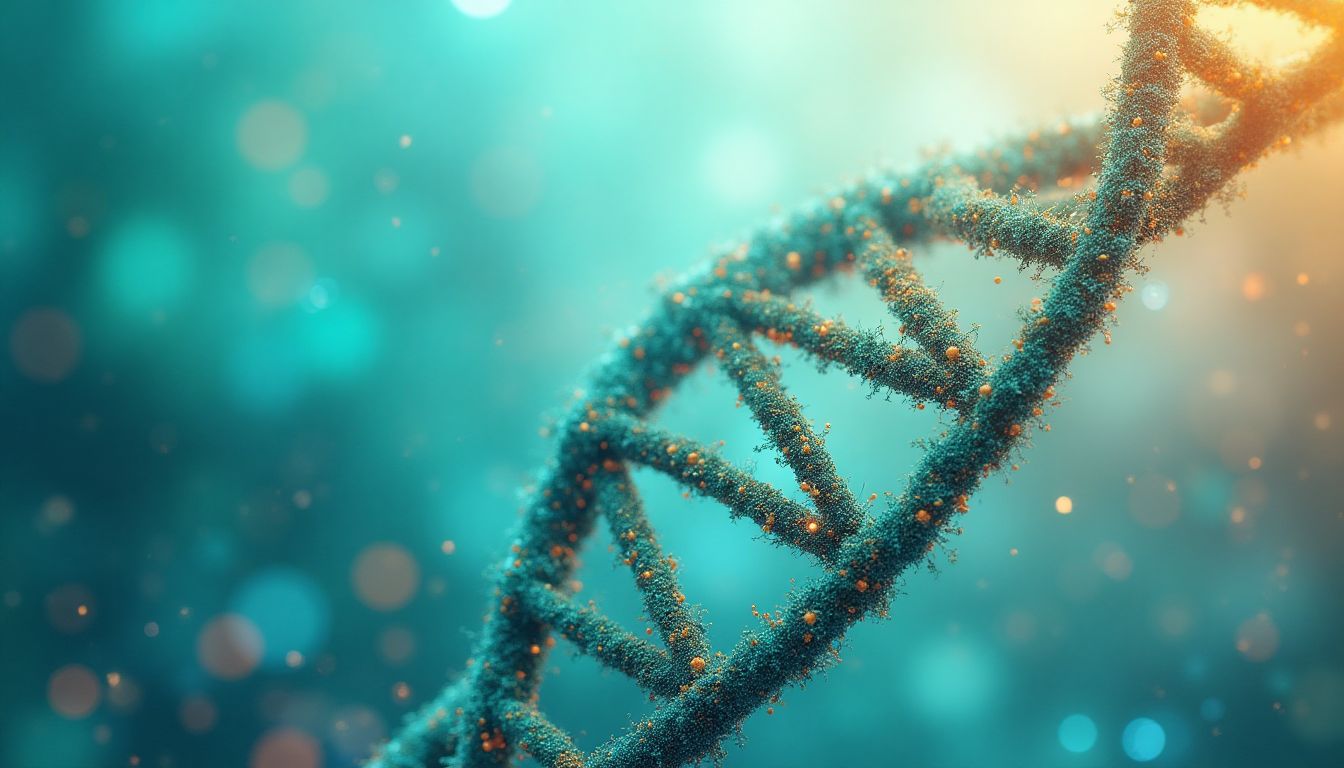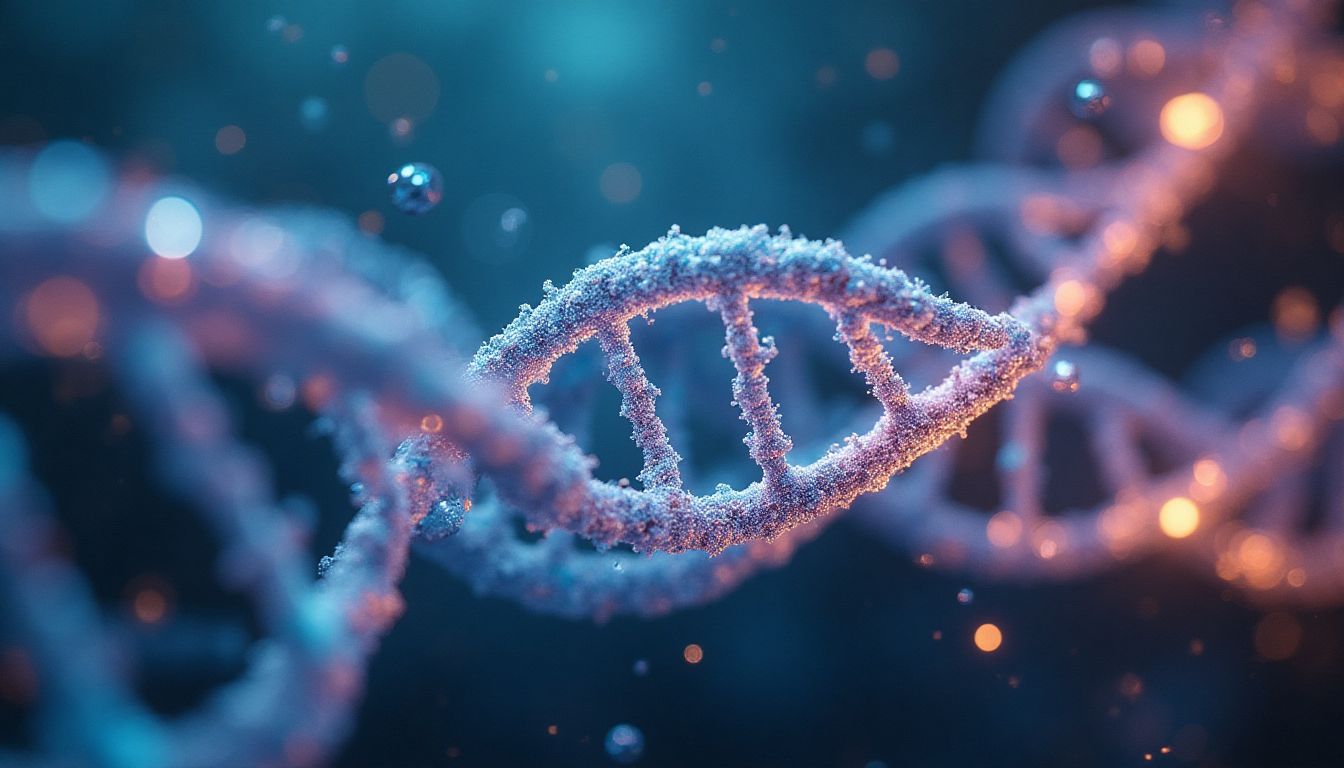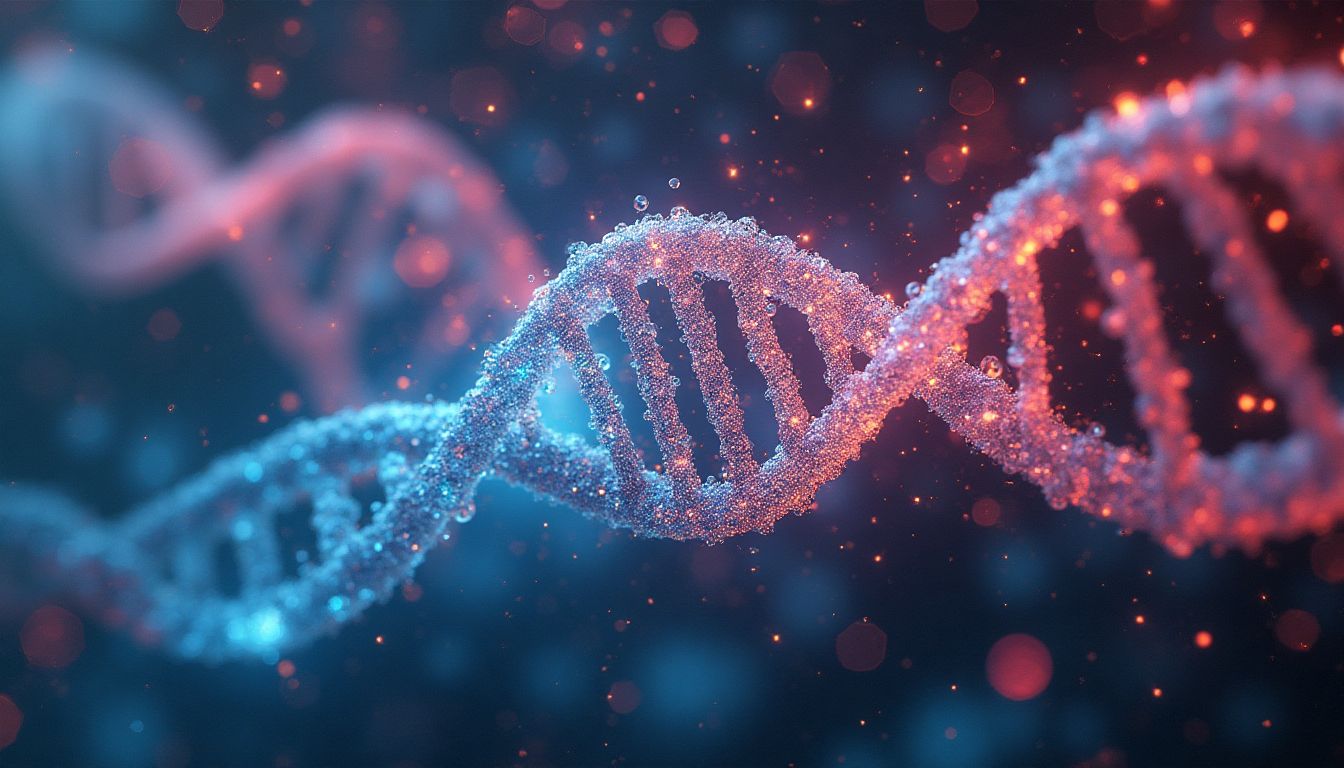Introduction: The Genetic Diviner
“The unexamined life is not worth living.” - Socrates. But what if your life could be examined not just in hindsight, but in foresight? Imagine a world where we can predict the future of humanity not by gazing at the stars, like the ancient seers, but by examining our very DNA. Welcome to the age of Artificial Superintelligence (ASI), where biological destiny is written in code!
Hold onto your hats, because this isn’t science fiction anymore. In fact, 75% of people’s educational achievements can now be predicted by analyzing their DNA. This astonishing fact is no longer a mere whisper in research halls but a conversation starter in cafes. We’re on the dawn of a new scientific renaissance - one that blends the primordial with the digital. Arthur C. Clarke might have called it magic, but in 2025, we know better. It's the amalgamation of AI prowess and human curiosity.
Interestingly, this ambitious glimpse into our genetic potential has been discussed by thinkers like Ray Kurzweil, Nick Bostrom, and even Yuval Noah Harari. These intellectual heavyweights have toyed with the concept of AI shaping human evolution. Kurzweil predicted it with his theories about the singularity. Bostrom warned us of the ethical quagmires. Harari speculated on the social changes that would result. It feels like we’re playing God, not with dice, but with algorithms.
The real question isn't whether ASI can influence our evolutionary track, but how it's set to revolutionize it. Can machines guide us toward a perfected human form? Or might they unearth attributes we’d rather stay buried? The implications are vast and ambiguous, swinging us between utopian dreams and dystopian nightmares. Through the intertwining of genetic science and ASI, we draw closer to understanding not just our past, but perhaps weaving a more predictive, and hopefully, balanced tapestry of the future.
While the potential of technology is awe-inspiring, the ethical tightrope we tread is precarious. It demands exploration of deeper questions about humanity's essence. Is this the pinnacle of progress, or a bell tolling warnings of cautious optimism? Stay with me as we traverse this fascinating journey of codes, genes, and intelligent systems.
Foundations of Genetic Science and Human Evolution
Historical Overview of Human Evolution
Imagine peeking through a window into the distant past. Do you see a scenery full of Homo sapiens living in caves and using stones as tools? Human evolution is like an epic adventure full of surprises, taking place over millions of years. Our ancestors had a starting line shared with apes, but look where that journey has brought us today. From the first upright walk to the age of TikTok, every step, every leap, has been monumental.
About 6 million years ago, our journey began in Africa. Life wasn’t exactly a picnic. Back then, early humans had to fight saber-tooth tigers and gather enough food to survive. Physical traits like walking on two legs—bipedalism—slowly became our thing. It may not sound like a big deal to you, but it was a game-changer. This meant having our hands free for carrying tools, and for that matter, scrolling through phones in the future.
The story doesn’t stop there. By the time our species, Homo erectus, came into the picture around 2 million years ago, the ability to control fire was quite revolutionary. You could say they were the original master chefs of the prehistoric world. But it wasn’t just about roasting marshmallows—fire brought warmth and protection. Fast forward to us, Neanderthals and modern Homo sapiens, competing for survival. Over the next millennia, we expanded beyond Africa, spreading our presence far and wide.
About 200,000 years ago, migration began. Imagine hopping continents not for vacation but for sheer survival. Humans branched out into Eurasia, mingling with Neanderthals and Denisovans. Denisovans were like our distant third cousins. There were a lot of 'family reunions' in cold caves, with humans acquiring helpful traits like adapting to their environments, expanding their understanding of tools, and creating languages.
While it’s easy to imagine humans having their calendar alerts set for today’s lab-grown burgers, our ancient roots trace us back to being resourceful hunters and gatherers. Agriculture and settling in one place marked a huge shift in lifestyle. We were now farmers and builders, creating grand structures like the pyramids, yet somehow, we still needed our daily dose of social interaction.
Understanding the Genetic Code
So, what makes us, us? Buckle up, because understanding the genetic code is like unraveling a biological mystery worthy of Sherlock Holmes. At the very heart of our being lies DNA, the blueprint spelling out every single detail about us—from majestic blue eyes to the quirky way we twirl our forked spaghetti. In a way, it’s like the world's most intricate instruction manual, and humans never could resist a "Do It Yourself" project.
DNA, which stands for deoxyribonucleic acid—yes, that’s a mouthful even for a wizard—is the carrier of our genetic information. It's made up of bases called adenine (A), thymine (T), cytosine (C), and guanine (G). These bases combine in unprecedented ways, forming sequences that decide our hair color, height, and well, everything that makes us the unique beings we are.
But how does it all relate to evolution? The song “We Are Family” should be more popular among our genes, because pretty much every living organism shares some genes with us. Mind-blowing, right? It's like the ultimate organism social network.
We humans have been playing genetic tug-of-war through millions of years. Our genes have undergone countless variations courtesy of mutations, which are like unexpected remix tracks in the evolution album. Some mutations led to advantageous traits, allowing humans to adapt to their environments, like improving immune defense against deadly plagues or even producing enzymes to digest lactose from dairy.
Understanding the genetic Mashup party has come a long way thanks to technological advancements. We decoded the Human Genome Project in 2003, the ultimate reality show where the script of human life was fully unveiled. The project was a massive collaboration involving numerous scientists and played a key role in cavities we make at the dentist.
Knowledge of the genetic code isn’t just exciting; it’s empowering. From curing genetic disorders to personalized medicine, a deeper understanding of DNA is paving the way for a healthier tomorrow. It’s like having a backstage pass to the concert of life, where the soundtrack of evolution continues to play, albeit one overture at a time.
The Role of Natural Selection in Evolution
In the game of evolution, natural selection is like Mother Nature’s most brutal reality show, where the host decides who stays and who goes. Think of it like the original version of "Survivor," where contestants had no tribal councils but were voted off the island if they couldn’t keep up with environmental changes.
The concept is simple, yet brilliant. Natural selection is the process where organisms better adapted to their environment tend to survive and produce more offspring. Charles Darwin, our honorary guest star here, didn’t just come up with the theory—he practically turned evolution into Hollywood's next blockbuster.
Picture a Victorian rerun of The Bachelor, where genetic traits vie for the final rose. Some genetic traits, like being a camouflage expert, peacock’s feather-like tail, or cheetah’s lightning speed, get the rose and hence survive. Those without this genetic charisma don’t continue to the next round. Put simply, the stronger traits are passed down to their offspring, sculpting future generations for survival and success.
Darwin’s journey to the Galapagos Islands exposed this reality with mockingbirds, finches, and giant tortoises dazzling in mini adaptive miracles. Every slight variation played a critical role in their survival and transformations over thousands of generations.
In the world of natural selection, luck is off the table. It’s all about effective survival strategies. Imagine living through climate changes, geographical shifts, and even encounters with other species—all adding thrilling plot twists to the story of evolution. This, my friends, is what makes natural selection the original star-studded, running shoes-wearing reality series in the journey of life.
As humans, we're crafted through eons of natural selection too, driving the fierce development of our brainpower, our opposable thumbs, and our stellar understanding of puns—don’t underestimate the evolutionary sharpening of wit with humor. While nowadays we might not be running from predators daily, the echoes of those survival instincts still hit the snooze button each morning. Natural selection is the ancient force that continues to shape not just our journey but our very existence.
ASI Technologies and Their Application in Genetic Predictions
Overview of Artificial Superintelligence (ASI)
Imagine a world where machines are smarter than us. Sounds like something out of a sci-fi movie, doesn't it? But it's real and it's called Artificial Superintelligence or ASI. While we are still working on making machines just as smart as us, ASI goes beyond. It's like the Einstein of machines – able to think, reason, and problem-solve like a genius. Now, why should we care about ASI in the realm of genetics?
Well, ASI can see patterns in gigantic piles of data, patterns most humans might miss. Imagine an elephant trying to do needlepoint, quite tough, right? That's what solving huge genetic puzzles would be for humans. With ASI, these complex challenges become easier to tackle.
The first step in understanding ASI’s role in genetics is to appreciate its computing power. ASI, unlike IBM’s Watson or most current AI models, can process data at levels our brains can barely fathom. That means it can analyze our genetic code like a detective solving a grand mystery. And who knows what kind of medical marvels might surface from this? Maybe banana-flavored cough syrup that works like a charm!
Tools and Techniques for Genetic Analysis
Let’s take a closer look at some exciting tools and techniques in genetic analysis that ASI could elevate. One of the top tools today is genome sequencing. Think of it like reading a complex instruction manual for building a human. Modern sequencers read these “instructions” at blazing speed, which was unimaginable just a few decades ago. Thank heavens for having speedy readers on our team!
ASI enters the scene with its talent for handling this vast data volume and applying algorithms to predict patterns. With tools like Illumina sequencers or the CRISPR gene-editing technology, ASI can point out mutations tied to genetic disorders, improving diagnostics, and treatment development.
There are also techniques like GWAS – Genome-Wide Association Studies – where researchers hunt for genetic variations related to illness. ASI's superintelligence turns these processes into precise and turbocharged operations, making discoveries pop out like surprises in a magic show.
Predictive Modeling in Genetics
Now, buckle up as we dive into the world of predictive modeling. Imagine being a fortune teller, not with a crystal ball, but with bytes and bits. Predictive modeling in genetics uses statistics and algorithms to anticipate future health outcomes or predispositions in individuals. Confused? Worry not; it’s like predicting a cake’s taste by knowing its ingredients.
With ASI getting in on the action, these predictions can be far more accurate. Stanford University researchers delve into predictive modeling for spotting genetic markers for diseases such as diabetes or heart conditions even before symptoms show.
And it doesn’t stop there. Predictive modeling with ASI not only identifies potential medical issues, but it can propose personalized treatment plans. Picture a world where going to the doctor is no longer a waiting game but a tailor-fit experience based on your unique genetic map.
In essence, ASI is like a whiz kid in the classroom of genetic science, where it doesn’t just learn but predicts, analyzes, and adapts. It's like having a turbocharged version of Google’s search engine but specifically for genetics.
Fascinated by how ASI can transform our understanding of genetics and health? Or are you worried machines may become bogeymen? Dive into this exciting arena and share your thoughts. Stay curious and keep exploring!
The Intersection of Ethics and Genetic Optimizations
Ethical Considerations in Genetic Engineering
Imagine a world where you could design your baby to have blue eyes, genius-level IQ, and perfect health. It sounds like science fiction, but with genetic engineering, it's inching closer to reality. However, this raises a giant flashing neon question: Should we? The ethics of genetic engineering is not just a black-and-white issue. It's more like an endless spectrum of grays, with moral dilemmas popping up like weeds in a garden of possibilities.
One of the big ethical concerns is eugenics. This is like a shadow lurking behind all these advancements. Eugenics is the idea of selecting desired traits in humans, and history shows us it's riddled with discrimination and inequality. Remember the dark days of the Nazi regime? They took the idea of a "perfect race" to sinister heights. This is why many are wary of slipping down that slope again.
Then there's the issue of accessibility. If only the wealthy can afford genetic enhancements, it could lead to an even wider gap between the haves and have-nots. It'll be like a world divided between Genetically Perfect (G.P.) elites and Natural Born (N.B.) folks. Could science fiction movies like Gattaca be our future reality?
Another puzzle piece is informed consent. Let's say parents decide on genetic modifications for their unborn child. But who speaks for the child? This brings us to a core philosophical question: Do future humans have rights before they're even born? The topic can make your head spin.
The Implications of ASI in Human Evolution
Artificial Superintelligence (ASI) could act like a magnifying glass on the genetic evolution business. Picture this: ASI uses its towering intellect to predict what tiny changes in our DNA could make you live to 150, run faster than Usain Bolt, or solve a Rubik's Cube in milliseconds. The possibilities sound like the dreams of science nerds, right? But there's a catch—a big one.
With great power comes great responsibility. That's not just a Spider-Man quote; it's a call to action for ASI developers and scientists who flirt with genetic modifications. If ASI-driven evolution goes unchecked, we could end up with unanticipated side effects. Imagine creating a smarter human only to find out it leads to new mental health issues. It's like ordering a perfect dish but discovering hidden ingredients that don't sit well.
Further complications arise when considering global diversity. ASI-powered genetic modifications could inadvertently narrow the gene pool, leading to a less diverse—if healthier—human population. Evolution loves variety, and a lack thereof might make us susceptible to unforeseen diseases or environmental changes. It’s like betting everything on a single hand in a poker game; the stakes are high and risky.
Public Perception and Regulatory Frameworks
Ah, the court of public opinion—a place where scientific advances are met with both fascination and fear. When it comes to genetics and ASI, people generally have mixed feelings. On one hand, the potential to eradicate hereditary diseases is thrilling. But on the other, folks get jittery about the "Mad Scientist" stereotype running amok with human DNA.
This is where laws and regulations come into play. Governments, scientists, and ethicists must sit together like peace negotiators at a summit meeting to create rules that ensure responsible use of genetic technologies. CRISPR, anyone? This gene-editing tool itself sparked a whirlwind of debates and regulatory challenges.
While some countries have embraced genetic modification with open arms and clear guidelines, others have taken a more cautious approach. The United States, for example, has strict rules that require multiple layers of approval for genetic research on humans. Compare that to the United Kingdom, where regulations are a bit more lenient.
Humor me for a second: imagine a genetically enhanced spokesperson trying to explain these complex issues to us ordinary folks. "Yes, these enhancements might let us scale mountains with ease, but remember, my friends, it's Everest, not a molehill!" Making these topics accessible and understandable is crucial for public engagement and informed decision-making.
Future Scenarios: Genetic Optimizations and Human Society
Utopian and Dystopian Outcomes
The idea of using artificial superintelligence (ASI) to shape human evolution presents both magical dreams and terrifying nightmares. Imagine a world where diseases are eradicated, and humans live longer, healthier lives. That’s the utopian vision. But there's a flip side—a dystopian scenario where genetic optimizations become tools for discrimination, with only the wealthy accessing the benefits, increasing the gap between the "genetically privileged" and the rest.
In a utopian future, ASI could guide us to navigate complex genetic code, foreseeing potential diseases and mutations. This could help scientists develop preventive measures before issues arise. We’d see a society where nobody is hurt by hereditary illnesses and genetic disorders become a thing of the past. Imagine families thriving free from historical health burdens, and children born with the best traits from their parents, pushing humanity to new heights.
Here’s an exciting glimpse: researchers are exploring gene-editing technologies like CRISPR. Soon, they might allow precision changes in DNA to enhance how humans look and think. This feels like sci-fi, doesn’t it?
But dark clouds of a dystopian future also loom. Think about the fears surrounding "designer babies" or genetic tampering falling into the wrong hands. If ASI predictions are used without oversight, they could lead to selective breeding practices, standardizing what it means to be human. Here, diversity might shrink instead of flourish.
How does society prevent such bleak outcomes? Public discussion on ethics, laws, and regulations is crucial. Every voice matters in shaping how these technologies unfold. When science transforms evolution, uniting for collective, thoughtful decisions ensures we remain the masters of our destiny, not slaves to technology.
The Concept of the Post-Human Society
Picture a post-human society. It sounds wild, right? Here, humans evolve beyond our current understanding. Advanced genetic modifications could enhance our physical abilities, cognitive powers, or even emotional intelligence. What if you could learn new languages overnight or heal from injuries in minutes?
These enhancements lead us to the notion of transhumans—beings who are part human, part something extraordinary. How far should society allow such enhancements? Does it redefine what it means to be human? Will the term itself evolve, capturing the essence of augmented beings?
| Aspect | Potential Enhancement |
|---|---|
| Physical Ability | Strength, Speed, & Stamina |
| Cognitive Ability | Memory, Creativity & Language Skills |
| Emotional Intelligence | Empathy, Resilience & Stress Management |
Advances in biotechnology mean augmented humans aren’t distant fantasies. The possibilities are vast, from bionic limbs giving super strength to neural implants that accelerate learning capacity. Will these upgrades lead to a fairer society where everyone has equal opportunities? Or might it deepen existing inequalities, drawing a line between enhanced and natural humans?
Moreover, consider societal values like love, empathy, and compassion. Are they traits that can be programmed? How do they shape relationships among enhanced humans? Should there be limits, and who decides them? These questions challenge our perceptions of morality and identity.
The post-human era isn't just about science, it reflects our everlasting pursuit of greatness. It reflects freedom from biological limitations while exploring new human expression boundaries. Society stands at the threshold. The path ahead requires wisdom, empathy, and curiosity.
Long-Term Evolutionary Prospects with ASI
The long road of evolution stretches before us, influenced by ASI. Today, natural selection takes millennia to manifest significant changes, but ASI accelerates this timeline, analyzing complex genetic data in moments that once took centuries.
As researchers dive deeper into our genetic blueprint, ASI unveils patterns and connections unseen by the naked eye. What defines us at our core? Can ASI reveal hidden depths of the human genome? The prospect of controlled evolution isn't as fantastical as once imagined.
- Genetic Mapping: ASI might decode the entire human genome with unprecedented accuracy, marking a historical leap in understanding heredity.
- Predictive Analytics: ASI can forecast genetic trends and diseases, enabling interventions to optimize wellness and longevity.
- Adaptive Strategies: Evolution might become a guided process, where traits are curated to meet societal needs and environmental shifts.
The implications extend beyond science fiction. With ASI, adaptability becomes strategic rather than random. Will humans become distinct species, specially adapted to unique challenges? Or remain united, leveraging our diversity for common advancement?
Yet warnings must not go unheeded. All great power comes with responsibility. The narrative of ASI in evolution highlights our stewardship of collective fate. Ethical standards and unprecedented vigilance guard this journey to ensure it's wise, inclusive, and humane.
Long-term, society grapples with a paradox—will ASI end the randomness of evolution to ensure uniformity or spark diversity? Both routes lead to the development of humanity yet present different visions for future generations.
In considering evolutionary prospects with ASI, the goal is not replacement, nor superiority, but harmony. It weaves natural and artificial threads into a tapestry of innovation. As the future unfurls, may we nurture its possibilities together.
Dream with me for a moment—we stand on the brink of shaping what it means to be human. Genetic optimizations with ASI are more than aspirations; they're a chance to actualize our world, echoing aspirations that span cultures, lands, and generations.
Case Studies: Historical and Current Genetic Projects Involving ASI
Past Achievements in Genetic Predictions
Once upon a time, genetic predictions seemed like the stuff of science fiction. Think of it like the magic of predicting the weather but applied to our DNA. The journey began with the Human Genome Project, launched in 1990, which was a big leap in understanding our genetic blueprint. The project was a team effort involving scientists from across the globe, led by the National Human Genome Research Institute and the Oak Ridge National Laboratory. As a result, in 2003, scientists completed a map of human DNA, covering over 3 billion base pairs. Imagine trying to find your favorite book on a shelf with 3 billion books; that's the scale they worked on.
This massive achievement opened doors to understand genetic diseases better. For instance, it helped pinpoint the causes of diseases like cystic fibrosis and Huntington's disease, diseases whose causes were previously hidden in the mysterious sequences of DNA. Armed with this knowledge, the next natural step was to predict who might develop these diseases, just like seeing storm clouds on the horizon before a thunderstorm. This foresight wasn't just appreciated by scientists; it changed countless lives by providing a chance at early intervention. Because of these strides, parents can screen for potential genetic disorders in their children before birth, offering them a chance at healthier lives.
Current ASI Initiatives in Genetics
Fast forward to today, and the world of genetics is intertwined with Artificial Superintelligence (ASI). Imagine a super-smart assistant that helps you understand crazy complex stuff in seconds—ASI does exactly that for genetic data. It’s like having a puzzle guide for a million-piece puzzle.
One such impressive initiative is the St. Jude Cloud. Operated by the famous St. Jude Children’s Research Hospital, this initiative deploys ASI to accelerate pediatric cancer research. The vast computational power of ASI analyzes genetic data at lightning speed, seeking new insights into potential treatments.
Take another cool example: the DeepMind's AlphaFold project. In collaboration with EMBO, AlphaFold has demystified protein folding, a complex process crucial to cellular function. Like a master chef knowing how ingredients blend to create a dish, AlphaFold understands the folds and curls of proteins using ASI. This breakthrough gives scientists clues about genetic diseases and opens up new pathways for developing treatments. Heck, it's almost like having a crystal ball for healthcare!
Future Projects and Their Expected Impact
So what’s next on the horizon? With ASI in the mix, the potential seems infinite. If you thought flying cars were cool, imagine a future where ASI helps eliminate genetic disorders entirely. Consider these exciting possibilities:
- Gene Editing Advancements: ASI could refine techniques like CRISPR for precise genetic surgeries. Imagine a future where genetic disorders could be edited away like a typo in a text message!
- Data-Driven Genetic Counseling: Improved data analysis tools will offer personalized healthcare advice, like having a healthcare GPS guiding you through life.
- Predictive Healthcare Models: Personalized health models could leverage ASI to predict potential health issues—almost like a preventative life coach on your shoulder.
These initiatives are more than just interesting projects—they are the next chapter in human evolution. By merging technology with genetics, humanity might unlock answers to age-old questions about health and longevity.
Of course, these advancements won't come without people asking big questions and raising ethical considerations. Will everyone have access to these technologies? What about privacy concerns regarding one's genetic data? As societies grapple with these questions, the role of regulatory frameworks, like those explored by the European Commission, becomes ever more vital. Hence, the road ahead is an adventurous mix of scientific exploration, evolving ethics, and public debate.
In summary, ASI isn't just changing genetics—it's reshaping our future. Whether it's tackling incurable diseases, redefining the idea of wellness, or potentially eradicating genetic disorders, ASI initiatives in genetics signify new possibilities for tomorrow's world. Join us on this journey and let's marvel at the vast potential that awaits!
ASI Solutions
Artificial Superintelligence (ASI) is reshaping our understanding of genetic predictions and optimization. But how exactly can ASI tackle the complex challenges surrounding genetics in human evolution? This section will explore the methodologies through which ASI can address various problems, followed by an extensive roadmap that outlines a strategic approach for institutions, organizations, or governments to implement these solutions. The landscape of genetic science is not only filled with possibilities but also daunting challenges that ASI can help navigate.
To better understand how ASI can provide innovative solutions for genetic optimization, we’ll break this down into three core areas: data analysis, predictive modeling, and ethical considerations. These segments will detail how ASI can play a crucial role in addressing the intricacies of genetics, pushing boundaries that were once thought unattainable.
1. **Data Analysis:**
The first step towards optimizing genetics with ASI is collecting vast amounts of genetic data. This involves not only sequencing an individual’s genome but also compiling extensive databases filled with genetic information from various populations. ASI can process this data at lightning speed, identifying patterns, correlations, and anomalies that a human analyst could easily overlook. For example, the work of companies like 23andMe demonstrates how personal genomics has made waves, but ASI can take it further by mining vast datasets to discover hidden genetic links—enabling advancements in personalized medicine.
2. **Predictive Modeling:**
Once data has been analyzed, ASI can utilize predictive algorithms to model potential outcomes based on genetic information. This includes understanding how specific genetic traits correlate with health conditions, physical abilities, or even cognitive performance. By using machine learning (ML) techniques, ASI can simulate various scenarios, predict future trends, and suggest interventions. Institutions like GenomeWeb constantly explore genetic information and its implications, but with ASI’s power, the capacity to predict and optimize human evolution becomes not just a possibility, but a likely reality.
3. **Ethical Considerations:**
While harnessing ASI for genetic optimization could unlock numerous avenues, ethical frameworks need to be established to guide such developments. ASI must incorporate ethical decision-making processes into their algorithms, ensuring that genetic interventions are equitable and just. Collaborations with ethicists, geneticists, and sociologists can shape the standards that govern the use of this powerful technology. Institutions like the American Association for the Advancement of Science (AAAS) actively emphasize responsible practices in scientific advancement, showing the necessity of incorporating ethics as a core component from the outset.
Having outlined these methodologies, we can now turn our attention to the roadmap of actions that organizations or governments can take to embrace these ASI solutions effectively. This roadmap is inspired by proven strategies from scientific pursuits like the Manhattan Project, but tailored to our contemporary understanding of technology and ethics in genetics.
Actions Schedule/Roadmap (Day 1 to Year 2):
Day 1: Initial assessment meeting to outline goals and objectives of integrating ASI into genetic optimization; identify key stakeholders: geneticists, bioethicists, policymakers, and ASI developers.
Day 2: Form a strategic advisory board comprising various experts in genetics, artificial intelligence, and ethics to provide guidance on the roadmap's implementation.
Day 3: Establish partnerships with leading data science firms and biotechnology companies, such as Illumina, to utilize their genomic sequencing capabilities and databases.
Week 1: Conduct a comprehensive review of existing genetic databases to identify key datasets that can be leveraged for developing predictive models.
Week 2: Develop a transparent framework focusing on ethical implications surrounding genetic modifications and outline compliance protocols.
Week 3: Begin population studies involving diverse demographic groups to gather comprehensive genetic data, ensuring inclusivity and representative sampling.
Month 1: Launch an awareness campaign aimed at the public, detailing the benefits and ethical considerations of genetic optimization. Leveraging platforms like Facebook and Twitter to create discussions and integrate feedback mechanisms.
Month 2: Initiate the first round of genetic data analyses using ASI, focusing on a specific health condition prevalent in the chosen population.
Month 3: Publish findings and early models, highlighting correlations discovered and establishing a community of practice among geneticists, ethicists, and policymakers to discuss the implications.
Year 1: Roll out pilot programs that apply genetic predictions to optimize health outcomes, using collected data to adjust the ASI model continuously based on results.
Year 1.5: Evaluate the pilot program's effectiveness; adjust models based on outcomes and feedback from the community, ensuring that ethical frameworks are adhered to throughout.
Year 2: Expand successful pilot programs into broader applications, adapting ASI frameworks to address emerging findings and introduce new genetic interventions.
This roadmap aims to provide a robust framework for integrating ASI into genetic optimization and education to prepare society for potential changes. By taking it step by step, organizations can ensure that all voices are heard and the ethical implications are carefully scrutinized.
Conclusion: Embracing the Future of Genetic Evolution
As we stand at the precipice of a new era in human evolution, the interplay between Artificial Superintelligence (ASI) and genetic science offers immense promise and profound challenges. The insights gleaned from our exploration not only deepen our understanding of our genetic makeup but also pose vital questions about the trajectory of our species. Each of us is a tapestry woven from millennia of genetic evolution, yet the threads that define our future could be dramatically altered by the advances of ASI.
We have journeyed through the historical evolution of our species, understanding how genetic codes and natural selection crafted our existence. This foundational knowledge empowers us as we lean into the exciting, albeit uncertain, future where ASI holds the potential to tweak, refine, or even redefine human genetics. Imagine a world where diseases are conquered, and longevity is a tangible goal—this is no longer just science fiction but a conceivable reality.
However, this bright future comes with its challenges. Ethical considerations are paramount as we tread carefully into the realm of genetic engineering. Who gets access to these potentially life-altering technologies? How do we ensure that no group is left behind in this evolutionary leap? Our responsibility is to scrutinize the moral implications of our choices and the impact they bear on societal structures. With great power comes great responsibility; hence, a robust regulatory framework must guide this brave new world.
The intersection of public perception and regulatory oversight cannot be underestimated. As we embark on this genetic revolution, it’s essential to engage in open dialogues with diverse communities, ensuring that every voice is heard and valued. Our collective understanding of biotechnology shapes the paths we explore. Healthy skepticism, combined with informed advocacy, can foster a society that embraces the potential of genetic advancements without sacrificing humanity.
In conclusion, as we dive headlong into the convergence of genetic science and artificial intelligence, the future is undeniably exciting. With ASI acting as a catalyst, we can aspire not only to enhance our own experiences but also to foster a more inclusive and equitable world. The journey of human evolution is far from over; let’s make it a journey worth celebrating, one that reflects our highest aspirations and respects our shared humanity.
FAQ
What is Genetic Optimization?
Genetic optimization refers to the process of using techniques, such as genetic engineering and artificial intelligence (AI), to enhance the traits of living organisms, including humans. This can involve editing genes to improve health, intelligence, or almost any characteristic! It’s like taking evolution into our own hands. For more information, check out resources from the National Institutes of Health.
How does Artificial Superintelligence (ASI) relate to genetics?
Artificial Superintelligence (ASI) is an advanced form of AI that can outperform humans in virtually every task. In genetics, ASI can analyze vast amounts of genetic data, predict outcomes, and suggest the best genetic modifications. For more on AI, visit the OpenAI website.
Is genetic engineering safe?
Genetic engineering has its risks, just like many technologies. Scientists are careful and conduct extensive research to ensure safety. Advances in genetic science have also led to many successful therapies. For instance, GenomeWeb shares updates about the latest developments in genetic research.
What are the ethical concerns surrounding genetic optimization?
There are many ethical concerns, such as whether we should edit human genes at all. Questions about "playing God," human rights, and the long-term effects of genetic changes are important. The U.S. National Bioethics Advisory Commission discusses these issues in detail.
Can you give examples of genetic projects using ASI?
Sure! Some projects aim to modify crops to withstand heat and drought, while others focus on engineering microbes to clean up the environment. Research in these areas is ongoing at various institutions like NASA's Jet Propulsion Laboratory.
- CRISPR Technology: This tool allows precise editing of genes and can be used in various fields, including agriculture and medicine.
- Gene Therapy: Treatments that modify genes to cure diseases are being explored and have shown promising results.
- Designer Babies: This is a hot topic as it relates to choosing traits before birth, raising ethical questions.
What might the future hold for human evolution with ASI?
Some believe we may develop enhanced physical and mental capabilities through gene editing. Others worry about widening social inequalities. We have to think carefully about how we use these powerful tools. For insights on future scenarios, the Future of Life Institute provides valuable information.
How can I learn more about genetic science?
You can learn more about genetics through various online resources, courses, and books. Websites like the National Human Genome Research Institute are great places to start. Don’t forget to check your local library for books or documentaries on the subject!
Is there public concern about these technologies?
Yes, many people have concerns about genetic technology. These can range from moral issues to fears about new diseases. Public discussions and regulatory frameworks are important to address these concerns, ensuring technology benefits society as a whole.
Wait! There's more...check out our gripping short story that continues the journey: Rebirth
Disclaimer: This article may contain affiliate links. If you click on these links and make a purchase, we may receive a commission at no additional cost to you. Our recommendations and reviews are always independent and objective, aiming to provide you with the best information and resources.
Get Exclusive Stories, Photos, Art & Offers - Subscribe Today!





























Post Comment
You must be logged in to post a comment.